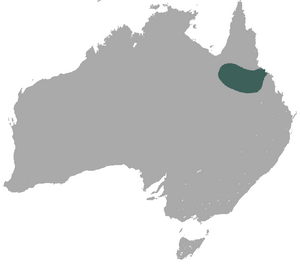Allied rock-wallaby facts for kids
Quick facts for kids Allied rock-wallaby |
|
|---|---|
 |
|
| Allied rock-wallaby on Magnetic Island, Queensland | |
| Conservation status | |
| Scientific classification | |
| Genus: |
Petrogale
|
| Species: |
assimilis
|
 |
|
| Allied rock-wallaby range | |
The allied rock-wallaby is a cool marsupial that lives in northeastern Queensland, Australia. It's also called the Weasel rock-wallaby. This animal is a type of rock-wallaby, which are small kangaroos that live in rocky places. It looks a lot like six other rock-wallaby species found nearby. These include the Cape York rock-wallaby and the Mareeba rock-wallaby.
Contents
What Does the Allied Rock-Wallaby Look Like?
It can be tricky to tell the allied rock-wallaby apart from its close relatives. Each type of rock-wallaby usually lives in a different area of Queensland. Sometimes, their living areas overlap a little.
Allied rock-wallabies have fur that is brown to grey on their backs. Their bellies are lighter in color. They often have a dark nose area and a dark spot near their armpits. You might also spot a light stripe on their cheeks and another light stripe across their hips.
Where Do Allied Rock-Wallabies Live?
The allied rock-wallaby lives only in Queensland, Australia. This means it is endemic to that area. You can find them from Townsville to the Burdekin River and the Bowen River. They also live on Magnetic Island and Palm Islands.
They like to live in rocky places, like mountains with cliffs and caves. They can be found in woodlands or areas with fewer trees. They even live near farms sometimes. They can live in places as high as 1,000 meters (about 3,280 feet) above sea level.
How Do Allied Rock-Wallabies Behave?
Allied rock-wallabies mostly eat grasses and the fresh shoots of plants. About 30% of their diet comes from browsing on bushes.
- Food and Foraging:
- They have a small home area when there's plenty of food, like during the wet season.
- During the dry season, when food is harder to find, they travel much further to search for it.
- When a young wallaby (called a joey) is out of its mother's pouch, it's often left hidden in rock cracks while the mother looks for food.
- Family Life:
- Allied rock-wallabies are usually monogamous in their behavior. This means a male and female often stay together.
- A baby joey grows inside its mother for about 30 days.
- The joey stays in its mother's pouch for six to seven months.
- It is fully weaned (stops drinking milk) when it's almost a year old.
- Young adult wallabies might move about two kilometers (about 1.2 miles) away from where they were born.
- They usually live for about seven years.
What is the Allied Rock-Wallaby's Conservation Status?
The allied rock-wallaby is found across a wide area in Queensland. It is quite common there. The number of these wallabies seems to be stable, and there are no big threats known right now. Because of this, the International Union for the Conservation of Nature (IUCN) says its conservation status is "least concern". This means they are not currently at risk of extinction.
However, some things can affect rock-wallabies in general:
- Climate change: This could change the types of plants that grow in their habitat.
- Introduced animals: Dogs and foxes that are not native to Australia can hunt them.
- Habitat changes: Their homes can be damaged, lost, or broken up into smaller pieces.
- Competition: Farm animals that are not native to Australia can eat the same plants as the wallabies.
- Fire practices: Changes in how people use controlled fires can also affect their habitat.
See also
 In Spanish: Ualabí rupestre aliado para niños
In Spanish: Ualabí rupestre aliado para niños


